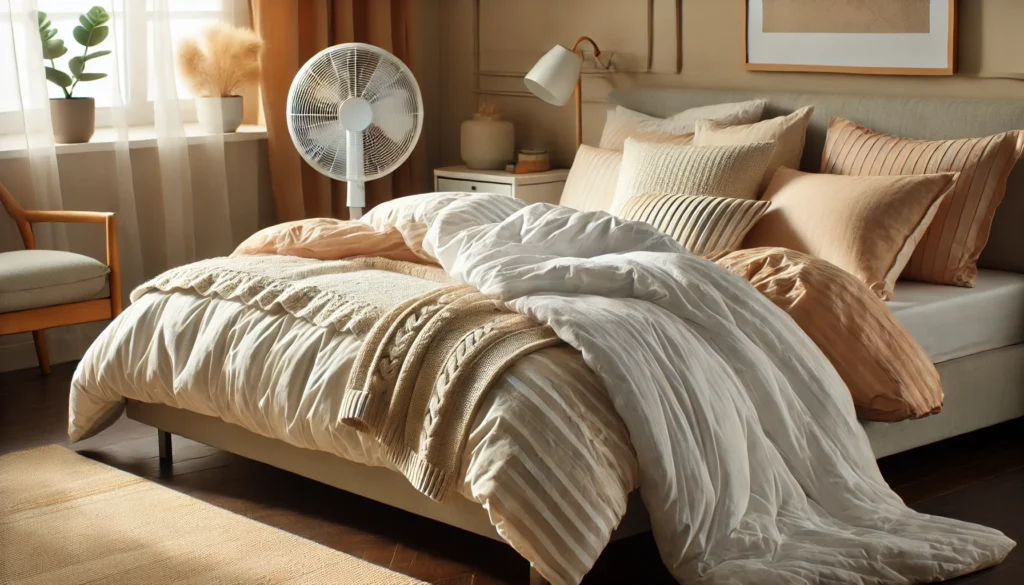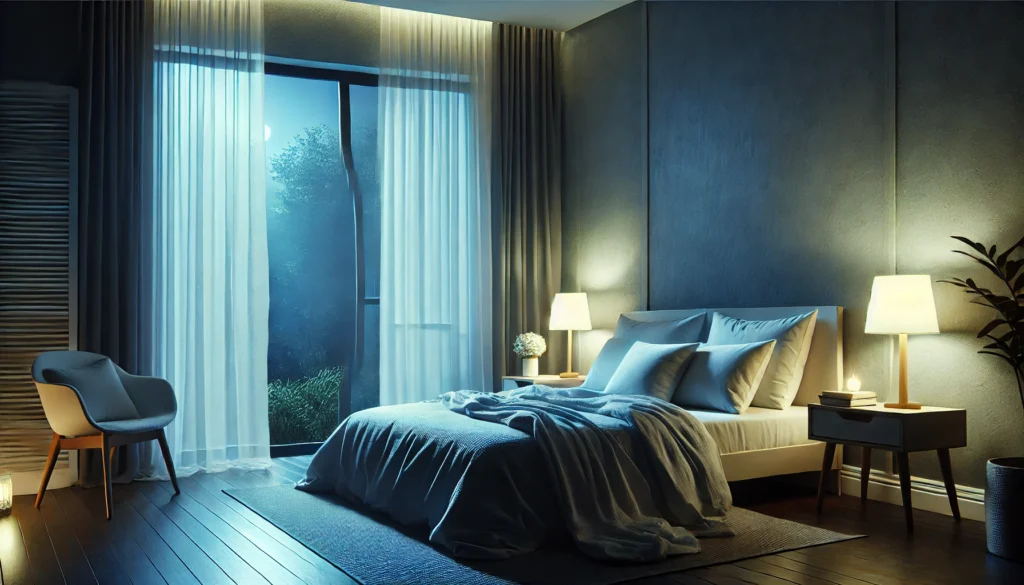Finding the perfect sleeping temperature is more than just a matter of comfort; it plays a significant role in determining the quality of your sleep and overall health. The delicate interplay between body temperature and the environment can profoundly impact how well you rest, influencing everything from your circadian rhythms to the stages of sleep. In this article, we will explore the science behind sleeping temperatures, the historical context of sleep environments, and practical advice on achieving your ideal sleeping temperature.
You May Also Like: Benefits of Consistent Sleep Schedules Explained
The Science of Sleep and Temperature
Understanding how temperature affects sleep requires a deep dive into the physiological processes that govern our sleep-wake cycles. The human body follows a natural 24-hour cycle known as the circadian rhythm, which regulates sleep patterns, hormone release, and body temperature.
The Role of Circadian Rhythm
The circadian rhythm is your internal body clock that dictates when you feel sleepy and awake. As evening approaches, your body begins to produce melatonin, a hormone that promotes sleep, while simultaneously lowering your core temperature. This natural cooling process is crucial for initiating sleep, as it signals to your brain that it’s time to rest. Disruptions to this rhythm, such as exposure to artificial light or irregular sleep schedules, can impede this temperature drop and affect sleep quality.
Does Core Body Temperature Change with Sleep?
As you prepare to sleep, your core body temperature naturally decreases. This drop in temperature is a signal to your body that it’s time to rest. Studies have shown that lower body temperatures are associated with the onset of sleep, and maintaining a cooler environment can help facilitate this natural process. Ensuring your sleeping environment supports this temperature drop can lead to more restful and uninterrupted sleep.
Increased Body Temperature at Night
Interestingly, while your core temperature drops as you fall asleep, it can rise slightly during REM (Rapid Eye Movement) sleep. This is a normal part of the sleep cycle, but significant increases in temperature can disrupt your sleep. Factors like heavy blankets, warm room conditions, or even certain medical conditions can lead to increased body temperatures at night, affecting sleep quality. Monitoring your sleep environment and making adjustments can help prevent these disruptions.
The Impact of External Temperature Changes
External temperatures can vary widely, depending on the season, location, and time of day. Adjusting your sleeping environment to account for these changes is essential in maintaining an ideal sleep temperature. Seasonal variations, such as colder winters and warmer summers, might require adjustments in bedding, clothing, and room temperature settings to preserve optimal sleep conditions.

Historical Context of Sleep Environments
Throughout history, humans have adapted their sleeping environments based on available resources and cultural norms. Ancient civilizations, from the Egyptians to the Romans, had unique methods of controlling their sleep environment, often utilizing natural elements like stone and clay to regulate temperature.
Ancient Sleep Practices
In ancient Egypt, people often slept on rooftops to take advantage of the cooler evening air, a practice that highlights the importance of natural ventilation. The Romans, on the other hand, employed hypocaust heating systems to maintain consistent warmth during colder months. Such historical practices underline the longstanding significance of controlling sleep environments for optimal rest.
Evolution of Bedding Materials
Bedding materials have evolved considerably over the centuries, from straw mattresses to modern memory foam. Each advancement reflects an ongoing quest for comfort and ideal sleep conditions. The transition to synthetic and high-tech materials in bedding showcases how innovation has continuously aimed to enhance sleep quality by regulating temperature and providing support.
Current Trends in Sleep Temperature
Today, advancements in technology have introduced new ways to optimize our sleeping conditions. From smart mattresses that adjust to your body temperature to climate control systems that maintain an ideal room temperature, the options are vast and continually evolving. These technologies offer personalized solutions that align with individual preferences and needs, further improving sleep quality.
What is the Optimal Room Temperature for Sleep?
While personal preferences may vary, studies suggest that the optimal room temperature for sleep falls between 60 to 67 degrees Fahrenheit (15 to 19 degrees Celsius). This range supports the body’s natural thermoregulation processes and aids in achieving deeper, more restorative sleep.
Best Temperature for Sleep: Women vs. Men
Research indicates that women may prefer slightly warmer sleeping conditions compared to men. This difference could be attributed to hormonal variations and metabolic rate differences. However, the consensus remains that cooler environments are generally more conducive to quality sleep for both sexes. Understanding these subtle differences can help tailor sleep environments to suit individual needs.
How Cold is Too Cold to Sleep?
Sleeping in an environment that is too cold can be just as disruptive as one that is too warm. Temperatures below 60 degrees Fahrenheit (15 degrees Celsius) may cause discomfort and lead to restless sleep. It’s important to find a balance that prevents shivering while still promoting the cooling of your core body temperature. Using additional blankets or adjusting the thermostat can help achieve this balance.
The Effect of Humidity on Sleep Temperature
Humidity levels in your sleeping environment can significantly affect how temperature is perceived. High humidity can make a room feel warmer, while low humidity can enhance the chill of cooler temperatures. Utilizing a humidifier or dehumidifier can help maintain optimal humidity levels, complementing your efforts to achieve the perfect sleep temperature.
Regional Variations in Sleep Preferences
Cultural and regional differences can also influence sleep temperature preferences. People in colder climates might be more accustomed to cooler sleeping conditions, while those in warmer regions may favor lighter bedding and more ventilated spaces. Understanding these variations can be beneficial when setting up your sleep environment, especially if you travel frequently or relocate.

Practical Tips for Achieving the Ideal Sleeping Temperature
Utilize Bedding and Sleepwear
Choosing the right bedding and sleepwear can significantly affect how comfortable you feel during the night. Opt for breathable fabrics such as cotton or bamboo that allow for better airflow and moisture-wicking properties to keep you cool. Layering your bedding can also provide flexibility, allowing you to add or remove layers based on your temperature preferences throughout the night.
Leverage Technology
Consider using a smart thermostat or a cooling mattress pad to maintain an optimal sleeping environment. These technologies can adjust the temperature based on your preferences and external conditions, ensuring a consistent sleeping environment throughout the night. Smart home devices offer an added level of convenience, allowing you to control your sleep conditions remotely or through automated settings.
Ventilation and Airflow
Enhance the airflow in your bedroom by using fans or opening windows when the weather permits. Proper ventilation can help dissipate heat and keep the room at a comfortable temperature. Ceiling fans or portable fans can also create a gentle breeze that makes the room feel cooler without drastically changing the temperature.
Seasonal Adjustments for Optimal Comfort
As seasons change, so should your approach to managing sleep temperatures. In the summer, lighter bedding and increased airflow can help keep your sleep environment cool. During the winter, heavier blankets and warmer sleepwear can provide the necessary warmth without overheating. Being proactive in adjusting your sleep conditions can ensure a comfortable and restful night’s sleep year-round.
Importance of Routine and Consistency
Establishing a consistent sleep routine can improve your body’s ability to regulate temperature naturally. Going to bed and waking up at the same time daily reinforces your circadian rhythm, making it easier for your body to manage temperature fluctuations. Consistency in your sleep environment, such as maintaining the same room temperature each night, can also enhance sleep quality.
The Future of Sleeping Technologies
The future holds exciting possibilities for the optimization of sleep environments. With ongoing research and development in sleep science, we can expect more personalized solutions that adapt to individual needs and preferences.
Innovations in Sleep Research
Emerging technologies like wearable devices and AI-driven sleep trackers promise to offer real-time insights into your sleeping patterns and environmental conditions. These innovations could potentially revolutionize the way we approach sleep optimization. By analyzing data from these devices, individuals can gain a deeper understanding of their sleep habits and make informed adjustments to their sleep environments.
Personalized Sleep Solutions
Future advancements in technology may lead to the development of highly personalized sleep solutions. Imagine a bedroom environment that automatically adjusts its temperature, lighting, and noise levels based on your unique sleep patterns. Such innovations could tailor every aspect of your sleep environment to maximize comfort and restfulness.
The Role of Artificial Intelligence in Sleep
Artificial intelligence has the potential to transform how we manage sleep environments. AI algorithms could learn from your sleep data and provide recommendations for improving your sleep quality. This could include adjusting temperature settings, suggesting changes in sleep schedules, or even recommending specific bedding materials. As AI technology continues to advance, its applications in sleep optimization will likely expand, offering new ways to enhance your sleep experience.

Conclusion
Finding your ideal sleeping temperature is an essential component of achieving restful and rejuvenating sleep. By understanding the scientific principles of thermoregulation, considering historical and cultural contexts, and applying practical strategies, you can create a sleeping environment that enhances your overall well-being. Embrace the advancements in sleep technology and personalized solutions to ensure that you wake up refreshed and ready to tackle the day ahead.
Incorporate these insights into your nighttime routine and discover the profound impact of a perfectly tuned sleeping temperature on your health and vitality. With the right balance, you can transform your sleep environment into a sanctuary for rest, allowing you to enjoy the full benefits of restorative sleep each night.
Further Reading:
What’s the Best Temperature for Sleep?
What’s the Best Temperature for Sleeping?
This is the ideal sleep temperature for older adults, new study finds
Important Note: The information contained in this article is for general informational purposes only, and should not be construed as health or medical advice, nor is it intended to diagnose, prevent, treat, or cure any disease or health condition. Before embarking on any diet, fitness regimen, or program of nutritional supplementation, it is advisable to consult your healthcare professional in order to determine its safety and probable efficacy in terms of your individual state of health.
Regarding Nutritional Supplements Or Other Non-Prescription Health Products: If any nutritional supplements or other non-prescription health products are mentioned in the foregoing article, any claims or statements made about them have not been evaluated by the U.S. Food and Drug Administration, and such nutritional supplements or other health products are not intended to diagnose, treat, cure, or prevent any disease.


